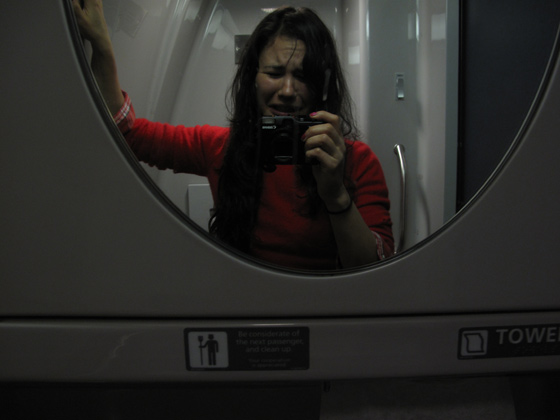American photo and video artist Laurel Nakadate, who graduated from Yale with her Master of Fine Arts in 2001, uses herself as a subject in her work. As described in her MoMA PS1 exhibit, Nakadate touches on “voyeurism, loneliness, the manipulative power of the camera and the urge to connect with others, through, within, and apart from technology and the media” (Biesenbach).

In her 2011 series, “365 Days: A Catalogue of Tears,” Nakadate ritualistically photographs herself crying each day for a calendar year (January 1 through December 31, 2010), sometimes in her own home, other times in airplane bathrooms or other public locations (see fig. 4). It is described as:
An elaborate opera about photographing one’s quiet, personal moments. It describes the struggle to understand the self in our fugitive, digital age, when 1.06 billion Facebook users feel perfectly comfortable sitting in private and revealing their deepest inner lives to anyone. The struggle to fix the idea of the self in the shuffle of modern life is the central problem for the contemporary self-portraitist. It's as if we are all Robert Corneliuses, staring credulously at arrays of the Hippolyte Bayards the world asks us to be. (Davis)
The 365 Days series is a year-long performative piece, giving the viewer the impression of having 365 snippets into Nakadate’s life. The style is intentionally very informal, with the lighting, white balance and setting often off-balance. Many of the portraits are simply Nakadate holding the camera in front of a mirror or at arm’s length, giving the impression of a spontaneous photo. Despite Nakadate’s professional training and obvious skill as a photographer, many of the images appear to have been taken by an amateur photographer. This faux-amateur nature lends itself to the validity of the images; that they are really just snapshots into a person’s life rather than part of a staged exhibition. As Rick Moody describes in Modern Papers:
These are also photographs, as opposed to artistic statements in other media, because these kinds of photographs – haunted, intimate, excessively revealing, and completely isolated images of young women – are one compelling story of femininity now. This is the story on the Web, in millions upon millions of blogs, and Facebook pages, and online sites advocating activities both wholesome and dangerous. The bulk of these online photographs of strangers, these accounts of self, are bad, are awkward, dimly lit, haphazard, consumer-grade, hopeless, and Nakadate plays with and against this constructed femininity; she includes the bad photos of herself, the ones where her eyes are nearly swollen shut, where the running makeup does not look like what you might find in the fashion photos of the '90s; there are running noses, inflammations, unsightly grimaces, things out of focus.
